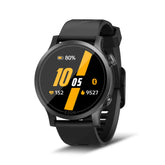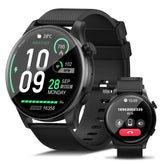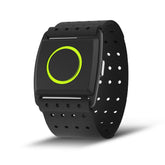Bouldering Basics: How to Climb Stronger, Safer, and Faster
Bouldering—climbing short, intense routes without ropes—is a thrilling way to build strength, problem-solving skills, and confidence. Whether you’re starting at a gym or eyeing your first outdoor boulder, this guide breaks down climbing techniques, essential safety tips, and targeted strength drills to help you climb smarter. Plus, discover how a bouldering watch elevates your training with route tracking and performance insights.
1. Core Bouldering Techniques: Master the Fundamentals
A. Footwork: The Foundation of Balance
- Edging: Press the edge of your shoe onto small footholds (e.g., on slab routes) — keep hips close to the wall to reduce arm strain.
- Smearing: Use the rubber of your shoe to stick to featureless surfaces by applying downward pressure (common on vertical or overhanging problems).
- Tip: Practice “stepping through” (crossing one foot in front of the other) to maintain balance on dynamic moves.
B. Handhold Mastery: Grip with Purpose
- Jugs: Large, secure holds for resting and planning—grab them with a relaxed grip to save energy.
- Crimps: Grip small edges with fingers bent at the first joint; start with shallow crimps and gradually increase difficulty to avoid pulley injuries.
- Pinches: Squeeze holds between thumb and fingers for aretes or slopers, engaging your forearms and core for stability.
C. Body Positioning: Move with Efficiency
- Dynamic Moves: Controlled jumps between holds—use hip momentum to generate power, landing softly to stick the grip.
- Static Climbing: Smooth, controlled movements for delicate balance problems (e.g., slab boulders), focusing on slow, precise foot placements.
2. Must-Have Bouldering Gear for Beginners
**A. Bouldering Watch
- Route Tracking: Log attempts, solve times, and grade progress with GPS or gym-based mapping (e.g., EZON Sports Watch auto-tracks climbs and syncs to Strava).
- Performance Metrics: Monitor heart rate during intense bouts to avoid overtraining; use recovery insights to schedule rest days.
- Durability: Shock-resistant and water-resistant designs (10ATM) for outdoor use, with long battery life for all-day sessions.
B. Climbing Shoes
- Indoor/Moderate Routes: Versatile shoes with moderate downturn (e.g., La Sportiva Tarantula) for comfort and edging ability.
- Steep Boulders: Aggressive, downturned shoes (Scarpa Instinct) to maximize toe power on overhangs.
C. Safety Gear
- Crash Pad: 4–6 inches thick with dual-zone foam (e.g., Mad Rock Mad Pad) to absorb falls; always climb with a spotter for highballs.
- Chalk Bag: Belt-mounted bag with a brush holder to keep hands dry and clean holds mid-route.
3. Strength Drills to Crush Your Projects
A. Finger Strength Training
- Hangboard Basics: Start with 10-second hangs on jugs (3x5 sets, 60-second rest) — progress to smaller holds (slopers, crimps) over 4–6 weeks.
- Grip Diversity: Train open-hand, crimp, and pinch grips separately to build balanced strength (e.g., 2x/week for 20 minutes).
B. Core & Back Strength
- Dead Bugs: Lie on your back, extend opposite arm/leg to improve anti-rotation strength (3x15 reps per side).
- Plank Variations: Side planks with hip lifts and weighted planks to support torso stability on dynamic moves.
C. Power & Explosiveness
- Bouldering Specific: Repeat 3–5 V0–V2 routes with 2-minute rest to build anaerobic endurance.
- Plyometrics: Box jumps and explosive push-ups to enhance dynamic movement power (2x10 reps, 3 sets).
4. Outdoor Climbing: Transitioning from Gym to Crag
A. Route Selection
- Start Low: Begin with V0–V2 boulders to practice outdoor features (crimps, slopers, and heel hooks).
- Study the Problem: Observe the route from the ground, noting key holds and foot placements before your first attempt.
B. Safety First in the Wild
- Landings: Check for rocks, roots, or uneven ground—position your crash pad to cover the entire fall zone.
- Warm-Up Thoroughly: Climb easy routes and do dynamic stretches (arm circles, hip swings) to prevent shoulder and finger injuries.
C. Weather Awareness
- Wet Rock: Avoid climbing on sandstone or limestone when wet—use a bouldering watch to check real-time weather forecasts and precipitation alerts.
5. Safety Tips for Every Climber
A. Warm-Up Rigorously
- 10-Minute Routine: Climb easy boulders, do finger stretches, and activate core muscles to increase blood flow.
B. Fall Safely
- Tuck and Roll: When falling, tuck into a ball, land on your crash pad, and roll to distribute impact—never stick your arms out to break falls.
C. Rest and Recover
- 48-Hour Rule: Rest fingers for 2 days after intense crimping sessions to avoid tendon injuries.
- Track Overtraining: Use your bouldering watch to monitor resting heart rate— a 5 BPM increase signals the need for extra recovery.
6. Sample 4-Week Training Plan
Week 1–2: Technique & Foundation
- 3 Days/Week: Focus on footwork drills and easy boulder problems (V0–V1).
- Strength: 2x/week finger hangs (jugs) and core work.
Week 3–4: Intensity & Power
- 4 Days/Week: Add dynamic routes (V1–V2) and 1 day of explosive drills (box jumps, campus board).
- Rest: 2 days of active recovery (yoga, walking) to improve mobility.
Climb Smarter, Not Harder
With the right climbing techniques, targeted strength drills, and a reliable bouldering watch to track progress, you’ll build confidence and efficiency whether in the gym or during outdoor climbing adventures. Remember, bouldering is as much about problem-solving as physical strength—approach each route with patience, prioritize safety tips, and let every send (successful climb) be a step toward mastery.
Gear up with EZON’s durable, feature-rich bouldering watch to log every climb, analyze performance, and stay safe on the rocks. Ready to start? Lace up your shoes, chalk up, and let the boulders be your classroom—every hold is a lesson in strength, strategy, and perseverance.
EZON Watch: Professional sports technology brand
https://ezonwatch.com
https://ezonwatch.com









